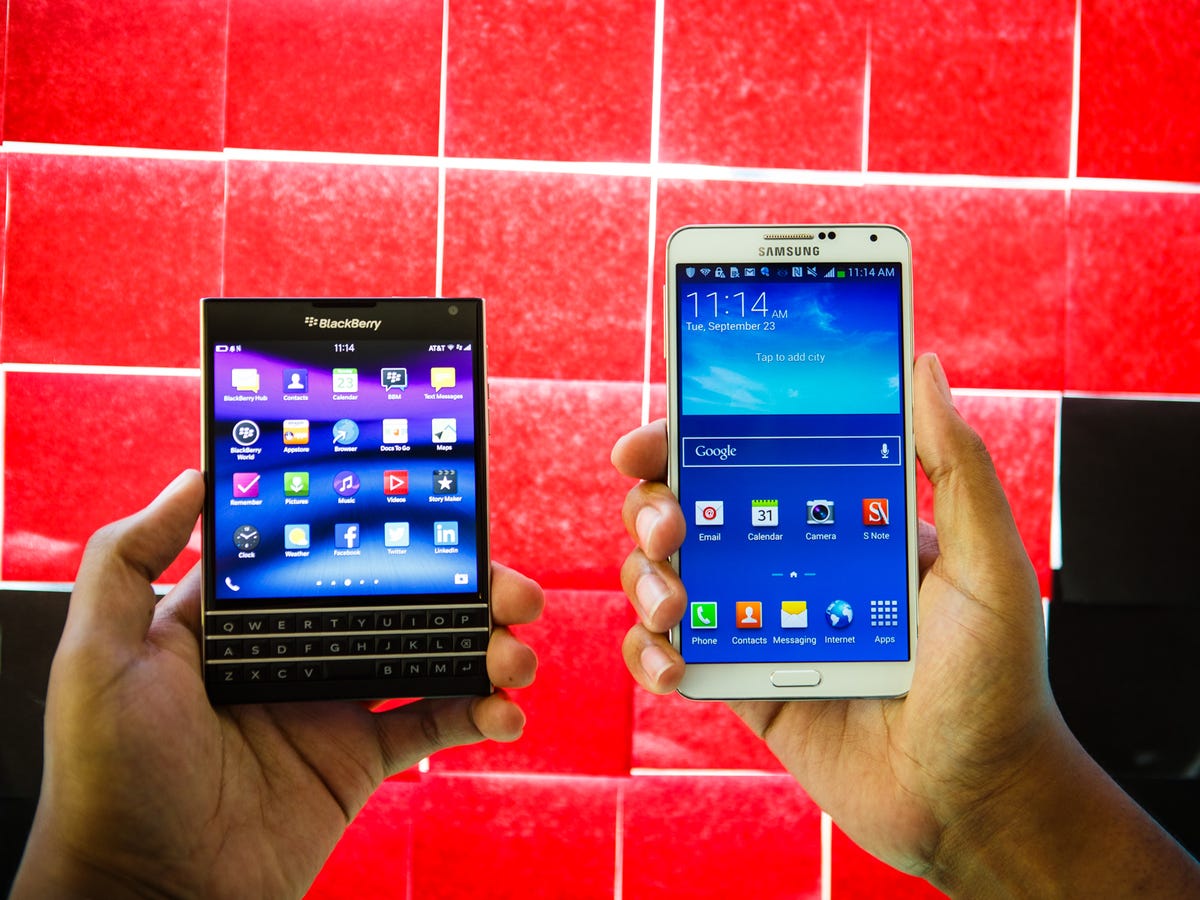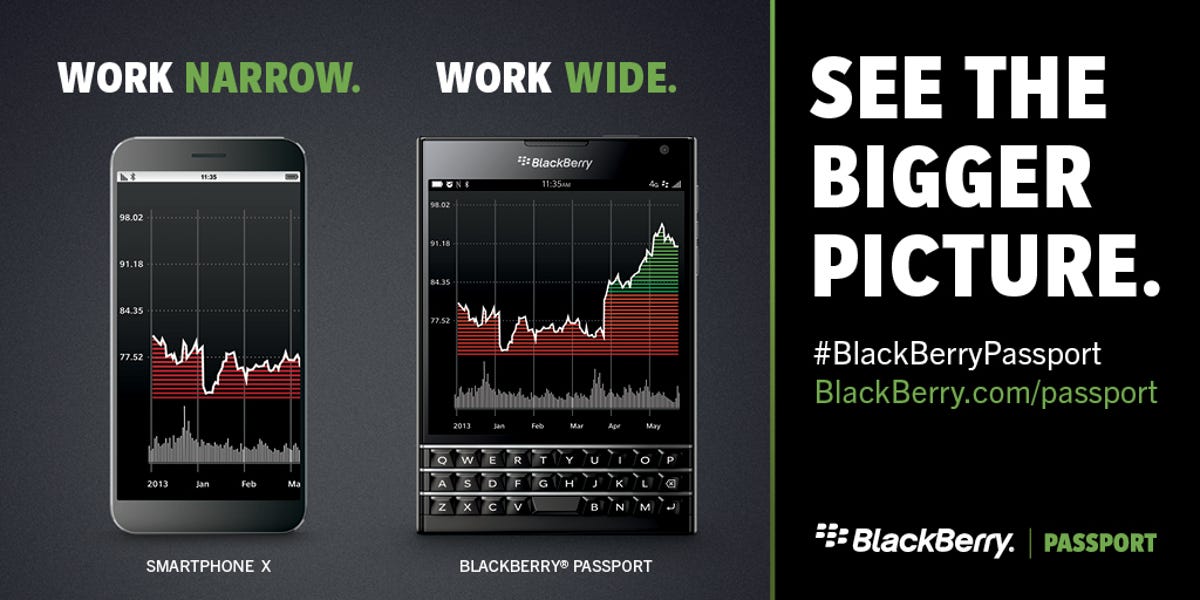The BlackBerry Passport may be just the kind of crazy the embattled company needs to get back into the smartphone conversation.

CNET
The squat smartphone, with its 4.5-inch square display and unique triple row of physical keys, is eye-catching. But whether the unorthodox look provokes sincere curiosity or snarky derision will depend on the individual.
Ultimately, it may not matter. For better or worse, the BlackBerry Passport stands out from the crowd of long, rectangular smartphones from the likes of Apple, Samsung and HTC. For a company like BlackBerry, which has lost virtually its entire market share in the smartphone market and is fighting for relevancy in a category it once dominated, being different gives the Passport a fighting chance. “The fact that it has a polarizing design makes people want to touch it,” said Maribel Lopez, an analyst at Lopez Research. “When you pick it up, you’ll either love it or hate it.”
Read more: CNET’s rated review of the BlackBerry Passport
BlackBerry faces numerous challenges in its bid for a comeback. Consumers have written off the company and the smartphones, especially after the debacle that was last year’s launch of the new BlackBerry 10 operating system. Most have moved over to an iPhone or Samsung smartphone, putting the company at a disadvantage in the growing trend of businesses letting their employees choose their own devices, with BlackBerry no longer the preferred device.


Now playing:
Watch this:
The cumbersome BlackBerry Passport is perfect for keyboard…
2:40
The fall from grace was startlingly quick. In 2008, nearly one out of every five smartphones was made by BlackBerry, and the term “CrackBerry,” used to describe people who were addicted to their messaging machines, was common in corporate culture. Six years later, it registers less than 1 percent, essentially “a blip” in the market, according to IDC analyst Ramon Llamas.
BlackBerry now has a completely different game plan from last year’s disastrous launch of the BlackBerry 10 operating system and the all-touchscreen BlackBerry Z10 smartphone. The strategy, ushered in by previous CEO Thorsten Heins, attempted to have BlackBerry stand toe-to-toe with Apple’s iPhone and Samsung’s Galaxy S and utilized a broad marketing campaign, exemplified by an ad in the Super Bowl. Aside from hardcore BlackBerry users, the platform and the debut device were largely ignored, resulting in a charge to the company of nearly $1 billion from unsold devices.


CNET
This year, BlackBerry plans to be more selective in its promotions. The company will go after what it calls “power professionals,” or people who are addicted to their mobile devices and constantly exchanging emails and messages.
For many of them — who are likely existing BlackBerry users unwilling to give up the physical keyboard — the Passport could be the ideal messaging workhorse. Despite its odd shape, the Passport is fairly easy to type on, and the wider screen size is advantageous when browsing the Internet or reading a spreadsheet or a document. The Passport feels like a premium device, using quality materials such as a stainless steel frame. “This is the BB10 device that BlackBerry users have been waiting for,” Llamas said.
BlackBerry has broader ambitions, and hopes some of those power professionals are iPhone or Android users who miss the tactile keyboard. But the company has a tough pitch to make.
‘Work Wide’
It was a whirlwind two months for Mark Wilson, senior vice president in charge of marketing for BlackBerry. Wilson, who previously worked for BlackBerry CEO John Chen at Sybase, joined in December 2013. By January, he was shown a soap mockup of the Passport.
“It definitely struck me as something that I hadn’t seen,” Wilson said in an interview. “It took me a moment to process it as a new category.”
In his mind, the Passport isn’t a tablet or a phablet, the term used for oversized smartphones such as the Samsung Galaxy Note 4 or Apple iPhone 6 Plus. Almost immediately after joining BlackBerry, he was tasked to create a marketing plan for a device for new strata of smartphones.


CNET
“It’s actually pretty exciting to launch something that’s unique,” he said, noting that the Passport stands out in the “sea of sameness.”
The name of BlackBerry’s campaign is “Work Wide,” emphasizing everything you can see on a wider screen, from a doctor’s X-ray image to spreadsheets and maps. The campaign highlights the things you can do with the screen that you couldn’t do before.
Don’t be surprised if you don’t see the campaign — this won’t be a mass-market effort. Instead, BlackBerry will be using a variety of social tactics and digital advertisement to “go after them where they go for information,” Wilson said.
Get a closer look at the BlackBerry Passport (pictures)






In BlackBerry’s estimation, power professionals make up 7 percent to 8 percent of the smartphone market, identified as highly educated, largely white-collar workers who are achievement-oriented and willing to spend on technology.
BlackBerry believes that if it can win over even half that segment, it will consider the Passport a success. “If we can target this group, we’ll be very profitable,” said BlackBerry Chief Operating Officer Marty Beard at a meeting with reporters held earlier this month.


BlackBerry
Moreover, Wilson expects that any success with the Passport may create a broader “halo effect” for those in the broader mobile professional market, which he estimates makes up nearly a third of all smartphone users. And then there are the customers who just want to be different.
“The wild card is how many folks want to stand out from the crowd,” said Rob Enderle, an analyst for the Enderle Group. “They don’t want an iPhone or Android clone. Sometimes that’s what can give you a boost you’re anticipating.”
Who is the Passport for?
The Passport, which harkens back to the blocky, track-wheel-equipped old BlackBerrys of the past, appears to be a perfect fit for the hardcore BlackBerry crowd. “This is the phone they should have done much earlier while they still had a huge installed base,” Enderle said.
But Chen has already touted another smartphone for that market: the BlackBerry Classic. The company believes the Passport can go after new users.
Related stories
- CNET’s review of the BlackBerry Passport
- New BlackBerry unit to focus on patents, software
- BlackBerry CEO ‘clarifies’ comments, says not selling devices biz
- BlackBerry narrows loss, but Wall Street had expected a profit
Still, it remains a tough sell.
BlackBerry has shored up some of its problems with consumer apps, partnering with Amazon and its Amazon App Store to provide apps for the platform. BlackBerry has worked to make sure Android apps downloaded from the Amazon App Store can work properly on its device, allowing BlackBerry users to download apps such as Netflix.
But the Amazon App Store doesn’t have every Android app, and its selection is still short of Google’s own Google Play app store and Apple’s App Store for iOS devices. BlackBerry itself still lacks a lot of key native apps, focusing largely on programs designed for enterprises.
As with the original BlackBerry 10 launch, the lack of carrier support remains a problem. BlackBerry plans to sell the Passport on its own site, ShopBlackBerry.com, as well as on Amazon. AT&T is the only carrier to confirm that it would sell the device.


Now playing:
Watch this:
Could BlackBerry and T-Mobile reconcile?
1:10
Ultimately, it’s the carrier stores where most smartphone sales occur. Sales staff at carriers, however, has little incentive to push the lesser-known smartphone in lieu of more popular smartphones that are available. “It’s just hard,” Lopez said. “If you’re not Apple or Samsung, you get no play.”
Wilson said BlackBerry has offered training to carrier employees, and noted that the company had gotten a lot of positive feedback.
“People will ask about it,” Wilson said. “We actually think that works to our advantage.”
So where does the BlackBerry Passport fit? It makes sense as a second company-issued smartphone, even if BlackBerry downplays that issue (it believes the Passport can be a person’s primary device). People still unable to use a touchscreen may also consider a switch back to BlackBerry. Success for the Passport is by no means guaranteed.
But if nothing else, BlackBerry is proving it’s still ticking. “A dead company can’t come up with new stuff,” Enderle said. “As long as you come up with new stuff, you’re challenging the perception that you’re dead.”



